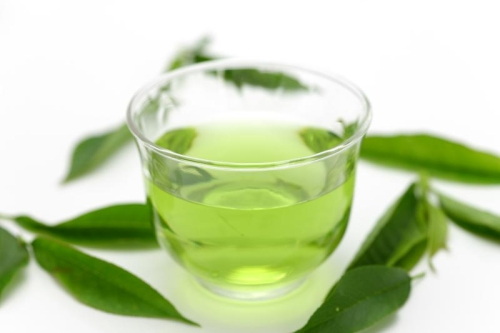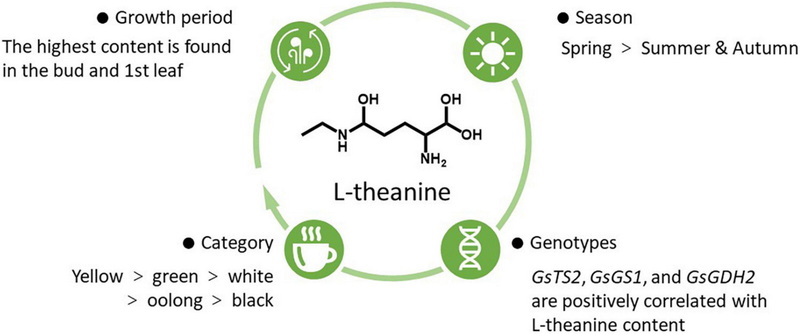Content Menu
● Methods for Theanine Extraction
>> Traditional Water Extraction
>> Solvent Extraction
>> Column Chromatography
>> Filtration Techniques
>> Ion Exchange Chromatography
>> Automated Extraction Methods
● Enhancing Theanine Concentration
● Applications of Theanine-Rich Extract
● Conclusion
● FAQ
>> 1. What is the best temperature for extracting theanine from green tea?
>> 2. How long should I steep green tea leaves to extract theanine?
>> 3. Can I use other solvents besides water to extract theanine?
>> 4. What is the purpose of using a polyamide column in theanine extraction?
>> 5. How can I concentrate the theanine extract after extraction?
● Citations:
L-Theanine, a unique non-protein amino acid, is primarily found in tea (Camellia sinensis)[5]. Known for contributing to the favorable umami taste of tea, it's also linked to various beneficial effects in humans[5]. As interest in theanine grows, both as a tea component and as an ingredient in functional foods and dietary supplements, efficient extraction methods become increasingly important[5]. This article explores the various methods for extracting theanine from green tea, providing a comprehensive guide for enthusiasts and researchers alike.

Methods for Theanine Extraction
Traditional Water Extraction
The most common and straightforward method for extracting theanine is water extraction. This process involves steeping green tea leaves in hot water to dissolve the theanine and other water-soluble compounds[1].
Materials:
- Green tea leaves
- Deionized water
- Muslin cloth or fine filter
- Beaker or pot
- Heat source
- Thermometer
Procedure:
1. Preparation: Weigh approximately 200g of commercial process quality green tea leaves[1].
2. Extraction: Heat 1600g of deionized water to 75-85°C (167-186°F)[1].
3. Steeping: Add the green tea leaves to the hot water and allow them to steep for about 45 minutes, stirring occasionally[1].
4. Filtration: Filter the resulting extract through muslin cloth to remove the tea leaves[1].
5. Re-extraction: Re-extract the residual tea leaves with another 1600g of deionized water at 75-85°C for 45 minutes and filter again[1].
6. Combining Extracts: Combine the two theanine extracts[1].
7. Concentration (Optional): Concentrate the extract using a rotary evaporator or by gentle heating to increase the theanine concentration.
Tips and Tricks:
- Use a water-to-tea ratio of about 25:1[1].
- Maintain the water temperature between 75-85°C to optimize theanine extraction[1].
- Ensure thorough filtration to remove any particulate matter from the extract[1].
Solvent Extraction
Solvent extraction involves using a solvent other than water to extract theanine from green tea leaves. This method can be more efficient in isolating theanine from other compounds[1].
Materials:
- Green tea leaves
- Ethanol (less than 20% by weight) or other suitable solvent
- Deionized water
- Filter paper
- Beaker
- Rotary evaporator
Procedure:
1. Preparation: Prepare a solvent mixture of water and less than 20% ethanol[1].
2. Extraction: Mix the green tea leaves with the solvent at room temperature for about 1.5 hours[1].
3. Filtration: Filter the mixture to remove the tea leaves[1].
4. Evaporation: Use a rotary evaporator to remove the solvent, leaving behind the theanine-rich extract[1].
5. Purification (Optional): Further purify the extract using column chromatography.
Tips and Tricks:
- Ethanol concentrations less than 20% are preferred to maintain solubility and prevent phase separation[1].
- Adjust the solvent-to-tea ratio to optimize the extraction yield[1].
- Ensure the solvent is completely evaporated to obtain a pure theanine extract[1].
Column Chromatography
Column chromatography is a purification technique used to separate theanine from other compounds in the extract. This method involves passing the extract through a column packed with a resin that selectively binds to theanine[1].
Materials:
- Theanine extract
- Resin (e.g., Amberlite XAD 16HP)
- Column (glass or plastic)
- Deionized water
- Ethanol
- Hydrochloric acid
Procedure:
1. Column Preparation: Pack a column with Amberlite XAD 16HP resin to a volume of about 350 mL (2.5 cm ID x 75 cm height)[1].
2. Equilibration: Equilibrate the column with deionized water[1].
3. Loading the Extract: Pump the theanine extract through the column until breakthrough occurs (about 100 mL)[1].
4. Washing: Wash the column with deionized water to remove non-phenolic materials[1].
5. Elution: Elute the theanine with a solvent mixture of water and ethanol[1].
6. Regeneration: Regenerate the column by passing a solution of sodium chloride or hydrochloric acid through it until the eluate turns neutral[1].
7. Final Wash: Wash the column again with deionized water to remove excess acid or salt[1].
Tips and Tricks:
- Ensure the resin is well-packed to prevent channeling[1].
- Adjust the ethanol concentration to optimize the separation of theanine from other compounds[1].
- Monitor the pH of the eluate during regeneration to ensure complete removal of residual chemicals[1].
Filtration Techniques
Filtration techniques such as microfiltration, nanofiltration, and ultrafiltration can enhance the purity of the theanine extract by removing high molecular weight materials[1].
Materials:
- Theanine extract
- Microfiltration membrane (0.45 μm pore size)
- Nanofiltration membrane (1000 Dalton MWCO)
- Filtration apparatus
Procedure:
1. Microfiltration: Subject the tea extract to microfiltration using a membrane with a pore size of less than 0.45 μm at a pressure of less than 50 psi[1].
2. Nanofiltration: Further purify the permeate by nanofiltration using a 1000 Dalton MWCO membrane to separate high molecular weight non-phenolic materials from theanine[1].
3. Concentration: Concentrate the theanine-rich extract using a rotary evaporator or vacuum concentration[1].
Tips and Tricks:
- Conduct microfiltration at a lower pressure to prevent membrane damage[1].
- Use a nanofiltration membrane with an appropriate molecular weight cut-off to effectively separate theanine[1].
- Monitor the concentration process to avoid over-concentration and potential degradation of theanine[1].
Ion Exchange Chromatography
Ion exchange chromatography is another method for purifying theanine extracts, particularly after nanofiltration. This process involves using a resin that selectively binds to theanine based on its ionic charge[1].
Materials:
- Theanine-rich extract
- Cation exchange resin
- Column
- Hydrochloric acid
- Buffers of increasing pH
Procedure:
1. Column Preparation: Pack a column with a cation exchange resin[1].
2. Acidification: Make the theanine-rich extract acidic (pH 2-3) using hydrochloric acid[1].
3. Loading: Pass the acidified extract through the column[1].
4. Washing: Wash the column to remove any residual acid or salt[1].
5. Elution: Elute the theanine with buffers of increasing pH[1].
6. Collection: Collect the further enhanced theanine-rich extracts[1].
7. Concentration: Concentrate the collected extracts[1].
Tips and Tricks:
- Adjust the pH of the buffers to optimize the elution of theanine[1].
- Monitor the flow rate to ensure proper binding and elution[1].
- Use high-quality resins to achieve better separation and purity[1].
Automated Extraction Methods
Automated extraction equipment offers a more efficient and controlled method for extracting theanine from tea leaves. These systems often involve fermentation chambers and precise control mechanisms[3].
Equipment:
- Fermentation frame
- Fermentation chamber
- Transmission cavity
- Sliding seat
- Motor
- Bevel gears
- Connecting rod
Procedure:
1. Setup: Place the tea leaves in the fermentation chamber[3].
2. Automated Process: Utilize the automated system to control the fermentation process, including temperature and humidity[3].
3. Extraction: Extract the theanine using controlled parameters[3].
4. Collection: Collect the extracted theanine solution[3].
Tips and Tricks:
- Regularly maintain the equipment to ensure optimal performance[3].
- Calibrate the sensors for accurate readings of temperature and humidity[3].
- Optimize the automated parameters based on the specific type of tea leaves used[3].

Enhancing Theanine Concentration
Several steps can be taken to enhance the theanine concentration in the final extract:
1. Multiple Extractions: Performing multiple extractions on the same batch of tea leaves can increase the overall yield[1].
2. Filtration: Filtration steps help remove impurities and concentrate the theanine[1].
3. Adsorption: Using adsorption techniques can further purify the theanine[1].
4. Concentration: Evaporating excess water under vacuum can concentrate the theanine without degrading it[1].
Applications of Theanine-Rich Extract
The resulting theanine-rich extract has various applications:
- Food and Beverages: Enhancing the theanine concentration of foods and beverages, such as green tea and green tea extracts[1].
- Dietary Supplements: Use in dietary supplements to promote relaxation, focus, and cognitive function[1].
Conclusion
Extracting theanine from green tea involves several methods, each with its advantages. Traditional water extraction is simple but may yield a less pure product. Solvent extraction, column chromatography, and filtration techniques offer higher purity but require more sophisticated equipment and procedures. Automated extraction methods provide efficiency and control, making them suitable for large-scale production. By understanding the factors that affect theanine extraction and employing the appropriate techniques, it is possible to obtain a high-quality theanine-rich extract for various applications.

FAQ
1. What is the best temperature for extracting theanine from green tea?
The optimal temperature for extracting theanine from green tea using water is around 80°C (176°F)[5]. This temperature balances efficient extraction with minimizing the degradation of theanine.
2. How long should I steep green tea leaves to extract theanine?
Steeping green tea leaves for about 30-45 minutes is generally sufficient to extract a significant amount of theanine[5]. Longer steeping times may extract more theanine but could also increase the extraction of other compounds like caffeine.
3. Can I use other solvents besides water to extract theanine?
Yes, you can use other solvents such as ethanol (less than 20% by weight) to extract theanine[1]. Solvent extraction can be more efficient in isolating theanine from other compounds, but it requires careful handling and evaporation of the solvent.
4. What is the purpose of using a polyamide column in theanine extraction?
A polyamide column is used to remove polyphenols from the theanine extract[1]. Polyphenols can interfere with the purity and taste of the final product, so this step helps to obtain a cleaner theanine extract.
5. How can I concentrate the theanine extract after extraction?
You can concentrate the theanine extract by using a rotary evaporator or by gentle heating under vacuum[1]. These methods remove excess water without exposing the theanine to high temperatures that could degrade it.
Citations:
[1] https://patents.google.com/patent/US7303773B2/en
[2] https://patents.google.com/patent/CN105061249A/en
[3] https://eureka.patsnap.com/patent-CN108517292B
[4] http://www.sciencemadness.org/talk/viewthread.php?tid=155451
[5] https://pubmed.ncbi.nlm.nih.gov/21735551/
[6] https://www.researchgate.net/figure/Comparison-of-L-theanine-extracted-for-different-durations-and-at-different-temperatures_fig2_376288028
[7] https://pmc.ncbi.nlm.nih.gov/articles/PMC9261829/
[8] https://cn.iherb.com/blog/l-theanine/1446
[9] https://onlinelibrary.wiley.com/doi/abs/10.1002/jsf2.175

 English
English 




























